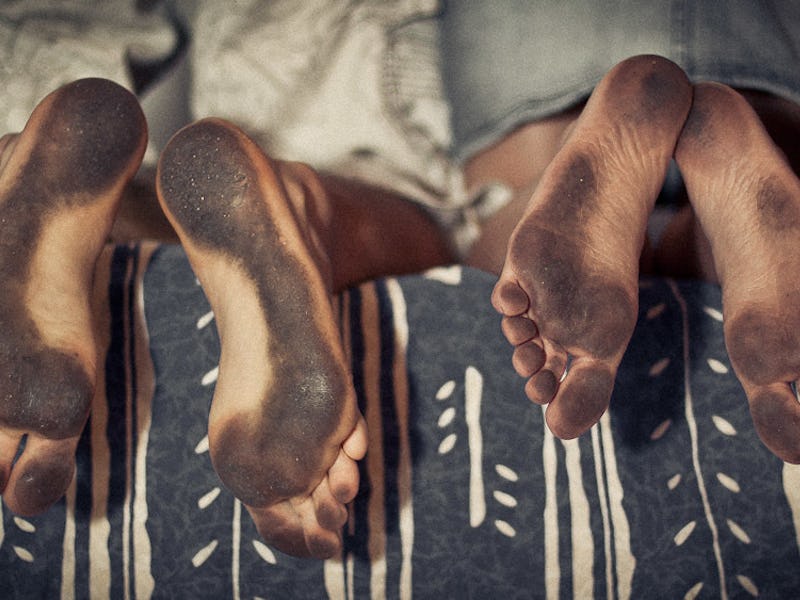The Disgusting Body Part That Captures Your Lover's Bacteria
You're swapping more than just spit.

If you live with a romantic partner, you may be accustomed to finding their hair in the shower drain, their shows on your Netflix account, and their dirty dishes in the sink. But according to new research, there may be a lot more of your partner around than you realize. According to a study published Wednesday in mSystems, an open-access journal published by the American Society for Microbiology, couples who live together share very similar skin microbiomes, especially on their feet. And what’s more, scientists found they could match sexually active cohabiting couples by their microbiomes with 86 percent accuracy.
Microbial communities consisting of bacteria, yeast, and viruses inhabit our entire bodies. Usually when we hear about the human microbiome, we hear about the microbes that inhabit the digestive system. But there are rich communities inhabiting our skin — the largest organ — too.
If you live with your romantic partner, odds are you both have very similar communities of microbes living on your skin.
Ashley Ross, Andrew Doxey, and Josh Neufeld, biologists at the University of Waterloo in Ontario, swabbed 17 different skin areas of 10 cohabiting heterosexual couples (20 people total). “The upper eyelids, outer nostrils, inner nostrils, armpits, torso, back, navel, inner thighs, bottom of feet, and palms of hands were sampled by the participants themselves using sterile foam swabs,” write the authors of the paper.
They sequenced the genomes of the samples to determine the composition of the colonies and found that even though location of samples and individual differences played the biggest roles in people’s differences in microbe diversity, cohabitation played a statistically significant role.
Further, when the researchers put the data into an algorithm to test whether couples could be discerned based on skin microbiome composition, they found that they could match couples with 86 percent accuracy.
The researchers report that the cohabiting couples in the study shared the most microbes on their feet, and the fewest on their inner thighs. They attribute the difference in thigh microbiome composition to differences in biological sex, since the vaginal microbiome is highly specific.
The study’s authors didn’t investigate why cohabiting couples share so much foot microbiota, but they speculated that it could have to do with the dust tracked around a home. Finding why this is could be an area of future study, as could skin microbiome research that involves a more diverse population than 90 percent white heterosexuals.
So next time you get grossed out when you see your partner using your toothbrush or when you find their hair in the soap, keep in mind that your skin bugs are already one big family.
Abstract: Distinct microbial communities inhabit individuals as part of the human skin microbiome and are continually shed to the surrounding environment. Microbial communities from 17 skin sites of 10 sexually active cohabiting couples (20 individuals) were sampled to test whether cohabitation impacts an individual’s skin microbiome, leading to shared skin microbiota among partner pairs. Amplified 16S rRNA genes of bacteria and archaea from a total of 340 skin swabs were analyzed by high-throughput sequencing, and the results demonstrated that cohabitation was significantly associated with microbial community composition, although this association was greatly exceeded by characteristics of body location and individuality. Random forest modeling demonstrated that the partners could be predicted 86% of the time (P < 0.001) based on their skin microbiome profiles, which was always greater than combinations of incorrectly matched partners. Cohabiting couples had the most similar overall microbial skin communities on their feet, according to Bray-Curtis distances. In contrast, thigh microbial communities were strongly associated with biological sex rather than cohabiting partner. Additional factors that were associated with the skin microbiome of specific body locations included the use of skin care products, pet ownership, allergies, and alcohol consumption. These baseline data identified links between the skin microbiome and daily interactions among cohabiting individuals, adding to known factors that shape the human microbiome and, by extension, its relation to human health.